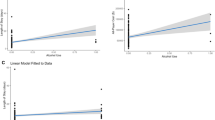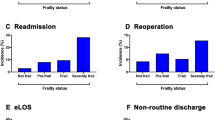Abstract
Purpose
The Hospital Frailty Risk Score (HFRS) is a frailty-identifying metric developed using ICD-10-CM codes. While other studies have examined frailty in adult spinal deformity (ASD), the HFRS has not been assessed in this population. The aim of this study was to utilize the HFRS to investigate the impact of frailty on outcomes in ASD patients undergoing posterior spinal fusion (PSF).
Methods
A retrospective study was performed using the 2016–2019 National Inpatient Sample database. Adults with ASD undergoing elective PSF were identified using ICD-10-CM codes. Patients were categorized into HFRS-based frailty cohorts: Low (HFRS < 5) and Intermediate-High (HFRS ≥ 5). Patient demographics, comorbidities, intraoperative variables, and outcomes were assessed. Multivariate regression analyses were used to determine whether HFRS independently predicted extended length of stay (LOS), non-routine discharge, and increased cost.
Results
Of the 7500 patients identified, 4000 (53.3%) were in the Low HFRS cohort and 3500 (46.7%) were in the Intermediate-High HFRS cohort. On average, age increased progressively with increasing HFRS scores (p < 0.001). The frail cohort experienced more postoperative adverse events (p < 0.001), greater LOS (p < 0.001), accrued greater admission costs (p < 0.001), and had a higher rate of non-routine discharge (p < 0.001). On multivariate analysis, Intermediate-High HFRS was independently associated with extended LOS (OR: 2.58, p < 0.001) and non-routine discharge (OR: 1.63, p < 0.001), though not increased admission cost (OR: 1.01, p = 0.929).
Conclusion
Our study identified HFRS to be significantly associated with prolonged hospitalizations and non-routine discharge. Other factors that were found to be associated with increased healthcare resource utilization include age, Hispanic race, West hospital region, large hospital size, and increasing number of AEs.

Similar content being viewed by others
References
Papanicolas I, Woskie LR, Jha AK (2018) Health care spending in the United States and other high-income countries. JAMA 319(10):1024–1039. https://doi.org/10.1001/jama.2018.1150
Poisal JA, Sisko AM, Cuckler GA et al (2022) National health expenditure projections, 2021–30: growth to moderate as COVID-19 impacts wane. Health Aff (Millwood) 41(4):474–486. https://doi.org/10.1377/hlthaff.2022.00113
De la Garza-Ramos R, Goodwin CR, Abu-Bonsrah N et al (2016) Prolonged length of stay after posterior surgery for cervical spondylotic myelopathy in patients over 65years of age. J Clin Neurosci 31:137–141. https://doi.org/10.1016/j.jocn.2016.02.017
Galivanche AR, Gala R, Bagi PS et al (2020) Perioperative outcomes in 17,947 patients undergoing 2-level anterior cervical discectomy and fusion versus 1-level anterior cervical corpectomy for treatment of cervical degenerative conditions: a propensity score matched national surgical quality improvement program analysis. Neurospine 17(4):871–878. https://doi.org/10.14245/ns.2040134.067
Le HV, Wick JB, Lafage R et al (2022) Surgical factors and treatment severity for perioperative complications predict hospital length of stay in adult spinal deformity surgery. Spine (Phila Pa 1976) 47(2):136–143. https://doi.org/10.1097/brs.0000000000004122
Passias PG, Jalai CM, Worley N et al (2018) Predictors of Hospital Length of Stay and 30-Day Readmission in Cervical Spondylotic Myelopathy Patients: An Analysis of 3057 Patients Using the ACS-NSQIP Database. World Neurosurg 110:e450–e458. https://doi.org/10.1016/j.wneu.2017.11.009
Stopa BM, Robertson FC, Karhade AV et al (2019) Predicting nonroutine discharge after elective spine surgery: external validation of machine learning algorithms. J Neurosurg Spine 31:1–6. https://doi.org/10.3171/2019.5.Spine1987
Yadla S, Ghobrial GM, Campbell PG et al (2015) Identification of complications that have a significant effect on length of stay after spine surgery and predictive value of 90-day readmission rate. J Neurosurg Spine 23(6):807–811. https://doi.org/10.3171/2015.3.Spine14318
Villavicencio A, Rajpal S, Lee Nelson E, Avoian S, Burneikiene S (2020) Unplanned 30-day readmission rates after spine surgery in a community-based hospital setting. Clin Neurol Neurosurg 191:105686. https://doi.org/10.1016/j.clineuro.2020.105686
Oh TK, Ryu JH, Han JO, Koo CH, Jeon YT (2021) Factors associated with a 30-day unplanned readmission after elective spine surgery: a retrospective cohort study. Eur Spine J 30(1):191–199. https://doi.org/10.1007/s00586-020-06541-1
Klineberg EO, Passias PG, Jalai CM et al (2016) Predicting extended length of hospital stay in an adult spinal deformity surgical population. Spine (Phila Pa 1976) 41(13):E798–E805. https://doi.org/10.1097/brs.0000000000001391
Passias PG, Poorman GW, Bortz CA et al (2018) Predictors of adverse discharge disposition in adult spinal deformity and associated costs. Spine J 18(10):1845–1852. https://doi.org/10.1016/j.spinee.2018.03.022
Zygourakis CC, Liu CY, Keefe M et al (2018) Analysis of national rates, cost, and sources of cost variation in adult spinal deformity. Neurosurgery 82(3):378–387. https://doi.org/10.1093/neuros/nyx218
Clegg A, Young J, Iliffe S, Rikkert MO, Rockwood K (2013) Frailty in elderly people. Lancet 381(9868):752–762. https://doi.org/10.1016/s0140-6736(12)62167-9
Leven DM, Lee NJ, Kothari P et al (2016) Frailty index is a significant predictor of complications and mortality after surgery for adult spinal deformity. Spine (Phila Pa 1976) 41(23):E1394–E1401. https://doi.org/10.1097/brs.0000000000001886
Yagi M, Fujita N, Okada E et al (2018) Impact of frailty and comorbidities on surgical outcomes and complications in adult spinal disorders. Spine (Phila Pa 1976) 43(18):1259–1267. https://doi.org/10.1097/brs.0000000000002596
Pierce KE, Kapadia BH, Bortz C et al (2021) Frailty severity impacts development of hospital-acquired conditions in patients undergoing corrective surgery for adult spinal deformity. Clin Spine Surg 34(7):E377–E381. https://doi.org/10.1097/bsd.0000000000001219
Miller EK, Neuman BJ, Jain A et al (2017) An assessment of frailty as a tool for risk stratification in adult spinal deformity surgery. Neurosurg Focus 43(6):E3. https://doi.org/10.3171/2017.10.Focus17472
Pierce KE, Passias PG, Alas H et al (2020) Does patient frailty status influence recovery following spinal fusion for adult spinal deformity?: An analysis of patients with 3-year follow-up. Spine (Phila Pa 1976) 45(7):E397–E405. https://doi.org/10.1097/brs.0000000000003288
Passias PG, Ahmad W, Kummer N et al (2022) Examination of the economic burden of frailty in patients with adult spinal deformity undergoing surgical intervention. Neurosurgery 90(1):148–153. https://doi.org/10.1227/neu.0000000000001756
Gilbert T, Neuburger J, Kraindler J et al (2018) Development and validation of a hospital frailty risk score focusing on older people in acute care settings using electronic hospital records: an observational study. Lancet 391(10132):1775–1782. https://doi.org/10.1016/s0140-6736(18)30668-8
McAlister F, van Walraven C (2019) External validation of the hospital frailty risk score and comparison with the hospital-patient one-year mortality risk score to predict outcomes in elderly hospitalised patients: a retrospective cohort study. BMJ Qual Saf 28(4):284–288. https://doi.org/10.1136/bmjqs-2018-008661
Shebeshi DS, Dolja-Gore X, Byles J (2021) Validation of hospital frailty risk score to predict hospital use in older people: evidence from the australian longitudinal study on women’s health. Arch Gerontol Geriatr 92:104282. https://doi.org/10.1016/j.archger.2020.104282
Flexman AM, Charest-Morin R, Stobart L, Street J, Ryerson CJ (2016) Frailty and postoperative outcomes in patients undergoing surgery for degenerative spine disease. Spine J 16(11):1315–1323. https://doi.org/10.1016/j.spinee.2016.06.017
Chan V, Wilson JRF, Ravinsky R et al (2021) Frailty adversely affects outcomes of patients undergoing spine surgery: a systematic review. Spine J 21(6):988–1000. https://doi.org/10.1016/j.spinee.2021.01.028
Hannah TC, Neifert SN, Caridi JM et al (2020) Utility of the hospital frailty risk score for predicting adverse outcomes in degenerative spine surgery cohorts. Neurosurgery 87(6):1223–1230. https://doi.org/10.1093/neuros/nyaa248
Ton A, Shahrestani S, Saboori N et al (2022) The impact of frailty on postoperative complications in geriatric patients undergoing multi-level lumbar fusion surgery. Eur Spine J 31(7):1745–1753. https://doi.org/10.1007/s00586-022-07237-4
Pulido LC, Meyer M, Reinhard J, Kappenschneider T, Grifka J, Weber M (2022) Hospital frailty risk score predicts adverse events in spine surgery. Eur Spine J 31(7):1621–1629. https://doi.org/10.1007/s00586-022-07211-0
Miller EK, Vila-Casademunt A, Neuman BJ et al (2018) External validation of the adult spinal deformity (ASD) frailty index (ASD-FI). Eur Spine J 27(9):2331–2338. https://doi.org/10.1007/s00586-018-5575-3
Passias PG, Pierce KE, Passfall L et al (2021) Not frail and elderly: How invasive can we go in this different type of adult spinal deformity patient? Spine (Phila Pa 1976) 46(22):1559–1563. https://doi.org/10.1097/brs.0000000000004148
Akbik OS, Al-Adli N, Pernik MN et al (2022) A comparative analysis of frailty, disability, and sarcopenia with patient characteristics and outcomes in adult spinal deformity surgery. Glob Spine J. https://doi.org/10.1177/21925682221082053
Alas H, Passias PG, Brown AE et al (2021) Predictors of serious, preventable, and costly medical complications in a population of adult spinal deformity patients. Spine J 21(9):1559–1566. https://doi.org/10.1016/j.spinee.2021.04.020
Reid DBC, Daniels AH, Ailon T et al (2018) Frailty and health-related quality of life improvement following adult spinal deformity surgery. World Neurosurg 112:e548–e554. https://doi.org/10.1016/j.wneu.2018.01.079
Brown AE, Lebovic J, Alas H et al (2020) A cost utility analysis of treating different adult spinal deformity frailty states. J Clin Neurosci 80:223–228. https://doi.org/10.1016/j.jocn.2020.07.047
Passias PG, Brown AE, Bortz C et al (2022) Increasing cost efficiency in adult spinal deformity surgery: identifying predictors of lower total costs. Spine (Phila Pa 1976) 47(1):21–26. https://doi.org/10.1097/brs.0000000000004201
Zaed I, Bossi B, Ganau M, Tinterri B, Giordano M, Chibbaro S (2022) Current state of benefits of enhanced recovery after surgery (ERAS) in spinal surgeries: a systematic review of the literature. Neurochirurgie 68(1):61–68. https://doi.org/10.1016/j.neuchi.2021.04.007
Elsarrag M, Soldozy S, Patel P et al (2019) Enhanced recovery after spine surgery: a systematic review. Neurosurg Focus 46(4):E3. https://doi.org/10.3171/2019.1.Focus18700
Zileli M, Dursun E (2020) How to improve outcomes of spine surgery in geriatric patients. World Neurosurg 140:519–526. https://doi.org/10.1016/j.wneu.2020.04.060
Kim HJ, Steinhaus M, Punyala A et al (2021) Enhanced recovery pathway in adult patients undergoing thoracolumbar deformity surgery. Spine J 21(5):753–764. https://doi.org/10.1016/j.spinee.2021.01.003
Adeyemo EA, Aoun SG, Barrie U et al (2021) Enhanced recovery after surgery reduces postoperative opioid use and 90-day readmission rates after open thoracolumbar fusion for adult degenerative deformity. Neurosurgery 88(2):295–300. https://doi.org/10.1093/neuros/nyaa399
Author information
Authors and Affiliations
Contributions
AAE involved in conceptualization, methodology, data curation, formal analysis, investigation, writing review and editing, and project administration. ABK involved in methodology, data curation, formal analysis, and writing review and editing. JJZS involved in investigation, writing original, and writing review and editing. MS involved in data curation and formal analysis. BCR involved in investigation and writing review and editing. SC involved in investigation and writing review and editing. SS involved in investigation and writing review and editing. MRSS involved in investigation and writing review and editing. AMH involved in writing review and editing. S-FLL involved in supervision, resources, writing review and editing, and project administration. JHS involved in supervision, resources, writing review and editing, and project administration. EM involved in supervision, resources, writing review and editing, and project administration. DMS involved in supervision, resources, writing review and editing, and project administration.
Corresponding author
Ethics declarations
Conflict of interest
The authors have no competing interests to declare that are relevant to the content of this article. The authors did not receive support from any organization for the submitted work.
Additional information
Publisher's Note
Springer Nature remains neutral with regard to jurisdictional claims in published maps and institutional affiliations.
Rights and permissions
Springer Nature or its licensor (e.g. a society or other partner) holds exclusive rights to this article under a publishing agreement with the author(s) or other rightsholder(s); author self-archiving of the accepted manuscript version of this article is solely governed by the terms of such publishing agreement and applicable law.
About this article
Cite this article
Elsamadicy, A.A., Koo, A.B., Sherman, J.J.Z. et al. Association of frailty with healthcare resource utilization after open thoracic/thoracolumbar posterior spinal fusion for adult spinal deformity. Eur Spine J (2023). https://doi.org/10.1007/s00586-023-07635-2
Received:
Revised:
Accepted:
Published:
DOI: https://doi.org/10.1007/s00586-023-07635-2




